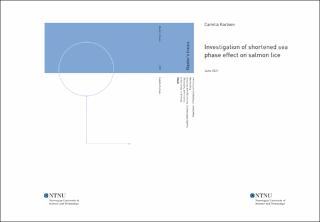| dc.contributor.advisor | Tyssedal, John Sølve | |
| dc.contributor.advisor | Båtnes, Anna Solvang | |
| dc.contributor.author | Karlsen, Camilla | |
| dc.date.accessioned | 2021-09-24T16:00:24Z | |
| dc.date.available | 2021-09-24T16:00:24Z | |
| dc.date.issued | 2021 | |
| dc.identifier | no.ntnu:inspera:75366163:20915337 | |
| dc.identifier.uri | https://hdl.handle.net/11250/2781478 | |
| dc.description.abstract | Lakselus (Leopeohtheirus salmonis) er en parasitt som påfører store økonomiske og økologiske konsekvenser for havbruksnæringen. I forsøk på å få kontroll over lakselusen tester oppdrettsnæringen ut ulike metoder og driftsmodeller. Målet med masteroppgaven er å undersøke om en forkortet sjøfase har en positive effekt på lakselusen ved å analysere ukentlige lusetall. I dette studiet er forkortet sjøfase oppnådd ved å plassere laksen i indre fjordsystem den første delen av produksjonen. Etter 7-9 måneder blir laksen flyttet ut til mer eksponerte lokaliteter langs kysten, hvor den blir værende til den er slakteklar.
Utviklingen av lakselus ble studert i produksjonsområde 7 og 8 i perioden 2012-2020, ved å undersøke lusetall fra lakseoppdretterne. For å sammenligne ulike driftsstrategier, har både ukentlige data fra produksjonssykluser driftet med en forkortet sjøfase og data fra helårsproduksjoner, både i fjordene og langs kysten, blitt analysert. De rapporterte lusetallene har blitt plottet mot ulike forklaringsvariabler for å undersøke deres påvirkning på lusetallene.
For å studere effekten av forkortet sjøfase, har både generaliserte lineære modeller, zero-inflated modeller og zero-altered modeller blitt tilpasset lusetallene. Resultatene i denne masteroppgaven indikerer at en zero-altered negativ binomisk modell ser ut til å passe til dataene, men regresjonsmodellen kunne ha blitt forbedret ved å inkludere numeriske variabler for saltinnhold og andre miljømålinger. I følge den tilpassede regresjonsmodellen er det lavere lusetall på oppdrettslaks inne i fjordene, sammenlignet med oppdrettslaks langs kysten. Regresjonsmodellen indikerer også at det forventede antallet voksne hunnlus for den undersøkte driftsstrategien, hvor forkortet sjøfasen oppnås ved å holde laksen inne i fjorden de første syv til ni månedene etter utsett, er mindre enn for helårsdrift i fjorden og langs kysten. | |
| dc.description.abstract | The salmon louse (Lepeophtheirus salmonis) is a parasite that inflicts major economic and ecological consequences for the Atlantic salmon aquaculture. In an attempt to gain control of the salmon lice, the aquaculture industry is testing various methods and operating models. The aim of this thesis is to see if a shortened sea phase has a positive effect on salmon lice by analyzing weekly lice numbers. In this thesis, a shortened sea phase is achieved by placing salmon in the inner fjord system during the first part of the production. After 7-9 months the salmon are moved to more exposed sites along the coast, where it remains until it is ready for slaughter.
The development of salmon lice have been studied in production area 7 and 8 in the period 2012-2021, by examining count data from the salmon farmers. To compare different operating strategies, both weekly data from production cycles operated with a shortened sea phase and data from year-round productions, both in the fjords and along the coast, have been analyzed. The reported lice numbers have been plotted against different explanatory variables to assess the variables impact on lice numbers.
To investigate the effect of the shortened sea phase, generalised linear models, zero-inflated models and zero-altered models have been fitted to the lice count data. The results in this thesis suggest that a zero-altered negative binomial model seems to fit the lice count data, but the regression model could have been improved by including numerical variables for salinity and other environmental measurements. According to the fitted regression model, lower lice numbers are associated with the cages inside the fjords compared with cages along the coast. The model also indicates that compared with year-round operations in the fjord and along the coast, there are expected a lower count of adult female lice for the investigated operating model, where the sea phase is shortened by keeping the salmon in the inner fjord systems the first seven to nine months after deployment. | |
| dc.language | eng | |
| dc.publisher | NTNU | |
| dc.title | Investigation of shortened sea phase effect on salmon lice | |
| dc.type | Master thesis | |
